How to Build a Dropshipping Store With BigCommerce & Aliexpress?
Drop-shipping is one of the many buzzwords currently circulating e-commerce merchants. Many people want to try their hand at this very minimal way of doing business because it’s a pretty quick and straightforward way to get your foot in the door selling online.
To make things even more accessible and materially leaner, you might partner up with a great e-commerce platform.
When it comes to credible, modern e-commerce websites that deliver outstanding results, BigCommerce definitely meets the criteria. You may still be curious about how to build a drop-shipping shop on the platform. Is it also a viable alternative for drop-shipping?
But first, what exactly is drop-shipping?
What is a Drop-shipping Business?
Drop-shipping is a retail delivery system in which a retailer does not keep stock of the products it sells. When a store uses the drop-shipping model to sell a product, it buys the item from a third party and gets it delivered directly to the buyer. As a consequence, the vendor is relieved of any inventory management.
The most important contrast between drop-shipping and conventional retail is that the selling retailer does not own or store inventory. Instead, the seller fulfills orders by purchasing inventory from a third party—usually a wholesaler or manufacturer—as requested.
There are four steps of a typical drop-shipping model.
- Your customer places an order from your online store
- Your store automatically sends the order to your drop-shipping supplier
- Your drop-shipping supplier prepares your customer’s order
- Your drop-shipping supplier ships the order directly to your customer
Reasons to Choose a Drop-shipping Business
1. Low beginning cost.
One of the most often asked questions I get is how much money I need to start a drop-shipping business.
According to studies, cashflow problems cause 82% of companies to fail or go bankrupt altogether. Another significant obstacle that entrepreneurs face is the startup budget. With drop-shipping, you don’t have to worry about all these obstacles, as drop-shipping helps eliminate or significantly reduce startup costs.
Here are some basic things to get you started:
- A platform. BigCommerce is a platform that allows you to sell (including domain name, hosting)
- A smartphone or a PC?
- Connection to the Internet
- Automation Apps
- Directory of Wholesale Suppliers

2. There is no need for stock or inventory.
Buying stock and keeping inventory are two of the most significant investments in the retail industry.
To fund these parts of their operation, smaller retailers typically take out loans or other financing sources. Most people who are launching their first online business don’t have a lot of resources at their disposal to buy products or the space to keep the products they will sell online.
Drop-shipping, on the other hand, does not include any of these money-related headaches. All you need to have is an image and a website. Isn’t it amazing that stock photographs can be used to replace real stock?
You find the Dropshipper you want to partner with. They will then give you access to their product images in order for you to post them on your BigCommerce website, online blog, or whatever places. When a customer orders a product, you then order the product from those that have the product, and they will take care of the delivery.
And since you don’t have physical stock, you don’t have to invest in inventory either. It is not to mention there are apps that automatically update your virtual store, so no need to worry about counting anymore.
3. Is a Warehouse Necessary?
Who needs a warehouse when the supplier already has one or more?
Small retailers face storage challenges, but drop shippers do not.
Here are some of the benefits of drop-shipping when the cost of a warehouse is not included.
- No warehouse renting
- No need for warehouse operations applications
- No need for warehouse workers’ payments,
- No need to worry about cooling and other temperature control methods
You can now run your company without having to worry about storage.

4. Low Running Cost
Drop-shipping can be achieved from the comfort of your own house, on your mobile, tablet, or computer, saving you money on office rent.
Unless you’re rapidly expanding and eager to scale, you do not need to recruit support staff just yet; you will save money on Human resource management, employee benefits, retirement plans, and employee dramas.
Most of the ICT infrastructure you’ll need, such as a computer and an internet connection, is likely already in your possession, cutting the startup costs even further.
For example, using Shopify to get your e-commerce store up and running saves you money on e-commerce website design and programming.
This design cost and other expenses hold the overhead down, allowing you to put your money where it needs most.
5. Win-Win situation for both you and the supplier
Using the drop-shipping method, you are not required to buy inventory that may not be purchased at all. When consumers have purchased a product, drop-shipping allows you to buy from store owners or distributors. It relieves you of some of their responsibilities while still making it easier for products owners to find buyers.
Drop-shipping for eCommerce saves you money because you only pay for items that have already been sold. For distributors, drop-shipping ensures further sales, inventory flow, and orders fulfilled. It is a win-win situation for you if you work with trustworthy wholesalers who are just trying to maximize their earnings.
6. You are the boss.
You do not have to share a room or a cubicle with nosy and distracting colleagues when you’re the boss.
Drop-shipping also allows you to work with multiple wholesale vendors to deliver more goods to your customers, giving you even more versatility.
Being the boss of your company means you’re solely responsible for the results, which requires your best efforts.
Similarly, you are responsible for both risks and benefits. Being a single entrepreneur is both thrilling and terrifying, but the rewards of operating a profitable drop-shipping e-commerce company much outweigh any disadvantages.

7. Being able to work from anywhere is a huge plus.
A drop shipper can work from Texas, ship from suppliers in China, and deliver to South Africa customers without ever leaving the computer.
Drop-shipping should be on your to-do list if you want to live a traveling-here-and-there lifestyle.
You can now every corner of the world as you’ve always wanted to, climbing Everest, visiting your grandmother in Sweden, or visiting Everest.
The best thing is that your company follows you everywhere you go, and you can also find new in-demand items to sell on one of your trips abroad.
8. There are a plethora of options to choose from
Without the constraints of space and operating costs, a drop-shipping retailer can give its consumers what they want: more options. Drop-shipping allows retailers to have a vast, constantly shifting inventory, which increases the likelihood of profits. There are hundreds, if not thousands, of choices to pick from.
There are also numerous niches to choose from. There’s plenty for everybody, whether you’re involved in maternity, infants, toys, or cars.
This variety means you can play with solutions you’ve never considered before, as long as they’re feasible and have promise based on your research findings.
9. Cross-Border Opportunities
Drop-shipping allows you to sell and ship to every place in the world.
Cross-border trade allows you to gain foreign sales, increase your consumer base, and enter new markets.
According to reports, 28% of Americans, 58% of Canadians, 29% of Britons, and 67% of Irish people shop both domestically and internationally.
For drop shippers seeking to expand internationally, these are future markets.
10. Automation.
The ability to automate makes drop-shipping much more straightforward than you would think. Importing products into your Shopify store, for example, can be a total pain if handled manually.
Aliexpress and other apps will help you totally simplify your drop-shipping company so you can concentrate on marketing.
Costly avoidable errors like inventory or pricing mistakes can be avoided with automation, saving time, resources, and improving performance.
In addition, the BigCommerce marketplace offers a variety of other applications and plugins that enhance the functionality of your online store.
A word of Caution:
Drop-shipping is not always shining and profitable. You can find out more at Cons of choosing a Drop-shipping Business
Cons of choosing a Drop-shipping Business
Drop-shipping is an order fulfillment process that eliminates the need for a business to have inventory on hand. Instead, the shop sells the item and then sends the purchase order to a third-party vendor, who then delivers the order to the buyer.
Drop-shipping is not, contrary to common opinion, a get-rich-quick scheme.
Sure, it seems to be easy money — you sell other people’s products and keep a share — but it’s far from simple when you consider all the disadvantages, challenges, and day-to-day management.
Drop-shipping will also help you create a profitable company if you do it correctly and use the tested strategy we have discussed in How to Start a Drop-shipping Business above.
But altogether, the process may not be as easy as you think it is.
Related Posts
1. Low-profit margins.
The overhead is minimal because you don’t have to manage or store your own product, but the returns are also low.
In other words, as you invest less effort, you get less money out. That means you’ll need to do a lot of work just to ensure operation, let alone make a profit.
Think of it this way: a large portion of the sale you make goes to the retailer. Your earnings are basically skimmed off the top.
That may not even be enough to cover the marketing and promotional costs, as well as the costs of running your website, handling sales orders, and staffing your office.
According to Fit Small Business, you can forecast your profits using these variables. Bear in mind that they’re just estimates, so they’ll vary based on your sector and situation.
- 20% margin.
- 2% conversion rate.
You can then calculate using this equation: Profit = (20% x Avg order value) x (2% x Traffic)
While this is correct for a premature initial estimate, there are a few issues to consider:
Odds are, your discount on purchasing from manufacturers and wholesalers will be less than 20%. The formula does not include all of the above-mentioned extra costs that you will be responsible for. It’s not the final revenue. It is not to mention that to keep your sales rates competitive; you’ll have to eat into your earnings on most goods. Your competitors can undercut you very quickly if you stubbornly cling to your 20% margin.
Furthermore, drop-shipping requires a lot of effort. Dropshippers must still negotiate with their bulk vendors, order processing, refunds, and customer support, despite its hands-off.
To sum up, drop-shipping may make more sense when you already have a steady stream of traffic.
2. Highly competitive.
Overly ambitious entrepreneurs will concentrate entirely on the “low overhead” aspect, ignoring the compelling evidence presented above.
Because starting a drop-shipping company requires relatively little money, there is a lot of competition, with the more successful markets losing more than others.
Essentially, the larger a business is, the lower it can reduce its markups in order to offer the lowest price
To reiterate what we previously said, smaller companies must sacrifice profitability in order to remain competitive with their costs, and this is unsustainable at a certain stage.
To make matters worse, most of not the only partner your suppliers work with. That me most of the timeans anyone, including me, could be offering the same products you are selling. When you’re only starting out, your competitors with years of experience will be able to undercut your costs because they have money, and you don’t.
Customers can get the same thing at a lower price somewhere, so why would they buy from you?
3. No control over supply-chain.
Typically, you are in control of customers who inquire about merchandise quality, delivery time, or return policy.
It is not the case with drop-shipping, as you’re more or less at the hands of your suppliers. Worse, because you are the seller in their eyes, you’re also the one who has to deal with your customers.
In other words, drop shippers are basically stuck, with no choice but to hope that the provider resolves the issues while still assuring the consumer of something beyond their control. Furthermore, communication is hindered when the drop shipper switches back and forth between the consumer and the provider. When you respond slowly, all conversation comes to a stop, and things take longer to resolve. Such communication delay will be so detrimental to your business, as it pushes your customers straight into your competitors.
And if they’re aggressive about it, those negative reviews might put your company out of business before it really gets started.
4. Problems of legal responsibility
Legal responsibility isn’t a prevalent issue for dropshippers, but it’s worth noting. Some retailers aren’t as trustworthy as they pretend to be, and you never know where the merchandise comes from.
Perhaps more cynical are manufacturers that, on a regular basis, use a trademarked logo or another company’s intellectual property without permission.
As a seller, you are automatically involved in any criminal practices your vendors engage in.
A solid Drop-shipping Agreement Contract will solve this possible challenge, but not every drop-shipping newbie is aware of this.
It’s something to keep in mind when making supplier choices.
5. It’s difficult to create a brand.
Dropshippers, like ghostwriters and behind-the-scenes songwriters, would accept the credit for their effort is given to someone else.
If the product you’re offering is truly outstanding, the customers will be so focused on the brand that they will completely forget about the shopping experience with you.
After all, the mark on the package isn’t yours.
In e-commerce, branding is critical since customers choose to buy at their preferred online retailers first.
You’ll never get the consistent traffic you need to run an online company, particularly a drop-shipping one if you don’t have customer loyalty.
How to Start a Drop-shipping Business?
How can I start a Drop-shipping Business? Aliexpress and Bigcommerce have the answer you are looking for.
Although you may have heard of “drop-shipping with Aliexpress” or “drop-shipping with Bigcommerce” before, it is still a good idea to dig deeper into the information before getting started.
After all, it is about your business and profits. You have the right to learn more about these platforms and how it operates.
So, are you curious as to how it works? So, let’s get off with the fundamentals.
How to start a drop-shipping business?
Though drop-shipping is an excellent choice for startups, you should conduct extensive research before getting started. The first step is to plan. It is therefore essential to follow a step-by-step process.
Choose a niche for your drop-shipping business:
The first step is to choose a niche that is appropriate for you. To make your drop-shipping company profitable, you must select the right products. You must consider the following factors when choosing products:
- Choose products that are both healthy and affordable.
- Choose the most well-liked pieces.
- Have the target demographic and audience in mind.
Finding Suppliers:
Finding suitable suppliers can be difficult. There are many suppliers, but picking the right ones is difficult.
Do not be lazy and only look at the first few pages while looking for vendors. To find a suitable supplier for your company, you must search through 30 to 40 sites. Suppliers aren’t concerned with selling tactics, so you will have to handle that for your online company.
You may be better off choosing a supplier that is highly recommended and is known for delivering on schedule.
Prepare A Questionnaire:
A questionnaire is important. If you do not want to be messed up, you must be open enough to ask your suppliers. Hesitation isn’t an option here. All questions must be presented to the supplier.
Making a list of your questions is a simple way to do this. As a result, you will not be confused when interacting with the retailer and will get all of the required responses.

Create your drop-shipping website.
The next step is to create your drop-shipping website. Many platforms make it possible to do so quickly. Here we choose BigCommerce.
It is not even important to have technical experience. In less than 2 hours, you can build your own online store using simple drag and drop features.
Get an order
How thrilling it must be to receive your first order?
But first, you need to have online processors like PayPal for getting payments. Having received the money from your customers, you can now place the order with Aliexpress dropshipper, and they will deliver the product to your customers.
Follow up:
If you want your drop-shipping store to thrive, you must be able to effectively answer customer inquiries. You have made a sale, but your job isn’t over.
In drop-shipping, excellent customer service is critical for establishing a positive market image and keeping consumers loyal to your shop.
How to Set Up a Drop-shipping Store on BigCommerce
When it comes to drop-shipping on BigCommerce, there are rules that can apply to anyone. That means how you set up drop-shipping can depend on your real-world connections and circumstance, as well as which marketplaces or applications you prefer to use. However, I’ll strive to be broad enough to appeal to a wide range of people while being precise enough to be helpful.
Step 1: Create a Sales Strategy.
A drop-shipping store’s simple marketing approach boils down to three factors: the merchandise, the brand, and the niche. You should spend some time planning how to take advantage of all three facets of an online shop.
It is a good idea, for example, to choose a category or group of products and then concentrate on attracting sales and traffic to create a community interested in those products.
Your branding can be influenced by the products you market. A well-thought-out branding and design style can go a long way towards establishing customer confidence. You should have a log, a tagline, and several other simple publicity materials to create a branding style.
This leads to a second point: who you want to target as key customers and on what channel. Facebook, for example, is an excellent platform for reaching out to new customers in their interest groups.
Step 2: Choose a Pricing Plan and Sign up.
BigCommerce offers three product options to select from, as well as a personalized Enterprise option. Fortunately, all policies have a 0% transaction fee as well as unrestricted merchandise, file storage, and user accounts, which is ideal for any size enterprise, especially small-sized businesses.
Bigcommerce, however, has a sales cap, which means that if you go over it, you will have to upgrade to a higher package. If you want to expand in the future, you should be mindful of this.
Customer groups and custom search filters are the two other significant functionalities not included in these plans. These are excellent features for your shop, and they may make you want to upgrade.
You can get started straight away with a free 15-day no-credit-card trial, after which you can use most of the features to design out the majority of your shop and get it ready to sell on release day. To use enhanced features and make your website live, you’ll need to sign up for a pricing plan.
Make a Drop-Shipping Store with BigCommerce.
One of BigCommerce’s 120+ e-commerce-ready templates will help you get started with your online shop. There are about twice as many templates as Shopify, and each design comes in three or four different styles, making the options much more diverse.
This template diversity, coupled with a few very specific niches, means you will most likely be able to find a blueprint that’s as similar to what you’re looking for as possible.
The template designers may not support drag-and-drop, which makes customizing a design a little more complicated. BigCommerce, on the other hand, allows you to use custom coding to fully configure your store’s models. If you want any custom features or a brand-new look, you can even hire someone specializing in BigCommerce development. But if you are okay with the given design and functions, templates already have all of the web pages you need to create a complete website. All you have to do now is fill in the blanks with your own material.
Step 4: Choose a Product Sourcing Application
The next move is to locate items that are suitable for your shop.
BigCommerce has many product sourcing tools that you can use to find products and display them in your store without needing to do it manually. However, there are significant differences in terms of quality and channels from which they will source.
Modalyst is one of the most well-designed and well-performing applications, but marketplaces can only use it in the United States and Europe, such as Stein.com and Wish.com. e-ProductPlug is another excellent software that uses a spreadsheet order system to target every online store. Its AliExpress applications are also the go-to spot for low-cost drop-shipping products, which are pretty impressive.
You can examine what each can and cannot do for your drop-shipping company. In an ideal world, an app must be able to:
- Assist you in your search for wholesale listings on online wholesale marketplaces.
- Add the items to your shelf with a single click,
- Send customer orders to drop-shipping suppliers automatically.
Step 5: Get Your Business Going
Once everything is ready, you can quickly launch your store and start selling by signing into your BigCommerce dashboard. Under “Review & test your shop,” there’s a button that says “Launch Store” at the bottom of the list. When you click this, the store will go live and be open to the public.
You should be able to sell and deliver goods to consumers with little or no effort if you use a decent drop-shipping app like those mentioned above. Everything you have to do now is kept selling and attracting traffic, refresh your inventory on a regular basis, and keep your prices competitive.
A word of caution:
Is BigCommerce a Good Platform for Drop-Shipping?
The answer isn’t as simple as it seems. Though there’s no denying that BigCommerce is a brilliant e-commerce site with excellent value for money when it comes to built-in functionality, templates, and applications, it is not built for drop-shipping in the beginning.
BigCommerce clearly sets a lower priority on drop-shipping on its website. There are fewer applications that appeal to this form of online sale and fewer resources to assist you in doing so. However, there are a few excellent drop-shipping applications, such as Modalyst, that cater to a higher-end, higher-margin market.
How to Set up a Drop-shipping Store with AliExpress
Why Aliexpress is the ideal option?
Aliexpress is a massive online store with a wide range of items. It allows you to sell those items from your online store. You don’t need to keep an inventory with Aliexpress.
Customers place orders with you as a drop shipper, and you contact Aliexpress suppliers to fulfill them. The vendors are in charge of the rest.
To get started with Aliexpress, you don’t need a lot of money upfront. In reality, you can easily do so by adding a few Aliexpress items to your store and then testing them.
Isn’t it fantastic?
Drop-shipping with Aliexpress, in my opinion, is the most secure way to begin your entrepreneurial journey.
Step-by-step guide to set up a Drop-shipping Store with AliExpress.
Installation.
- Go to app.woodropship.com and create a free account.
- Link your Woocommerce dropship shop to Woodropship from here.
- Install the Woodropship Chrome extension to import AliExpress goods.
- Now, press the mouse. Go to AliExpress and add the items you want to your Woodropship account from the top right corner.
Woodropship has made the creation and management of your drop-shipping business take just a few clicks. You can forget about the frustrating and tiring process of searching for suppliers, manually syncing inventory and prices because WooDropShip enables you to import thousands of aliexpress.com products to your store with just one click.

You can add products while browsing the aliexpress.com product catalog or product page. You can even use its in-app trending products page, so you don’t have to go through thousands of products to find a best-seller.
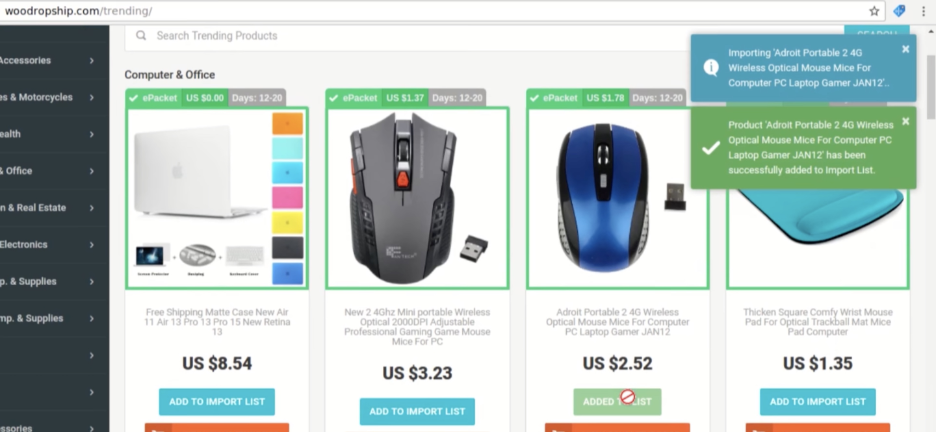
- To see the imports, go to Products> Import List on the dashboard.
Customization.
- Go to Settings> Global Pricing Rules and adjust the product’s price according to the pricing strategy. You can also monitor the settings for your orders and package updates from here (out of stock, unavailability, price changes, etc.).
On the dashboard (Products> My Products), you can see all of the displayed products. You can edit the cover, definition, variant info, and even the pictures to fit your website’s look and feel.
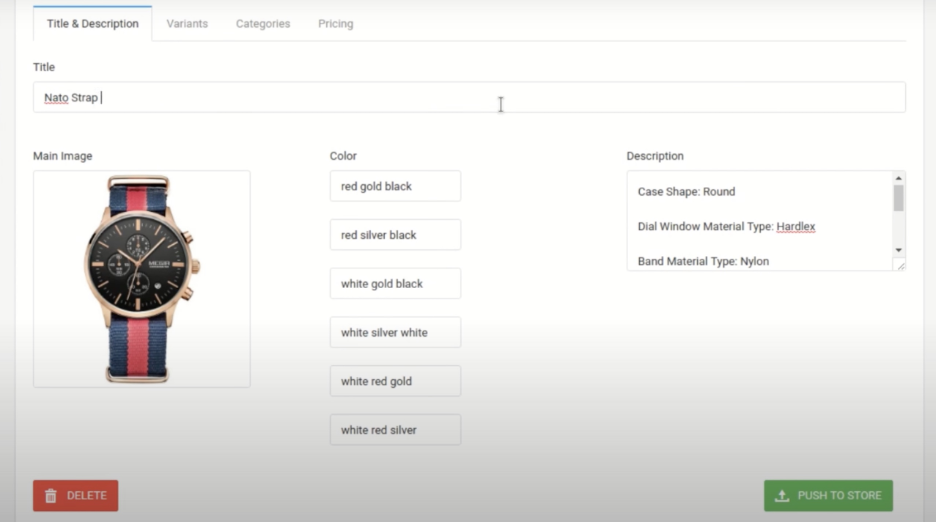
WooDropShip gives you control of the product title description and pricing. You can add a percentage or fixed markup Aliexpress product prices. You can also assign cents if you wish to. Woodropship will look out for changes in product inventory and prices on Aliexpress.com and update your WooCommerce store automatically. No longer have to worry about pricing fluctuations or selling products that are out of stock
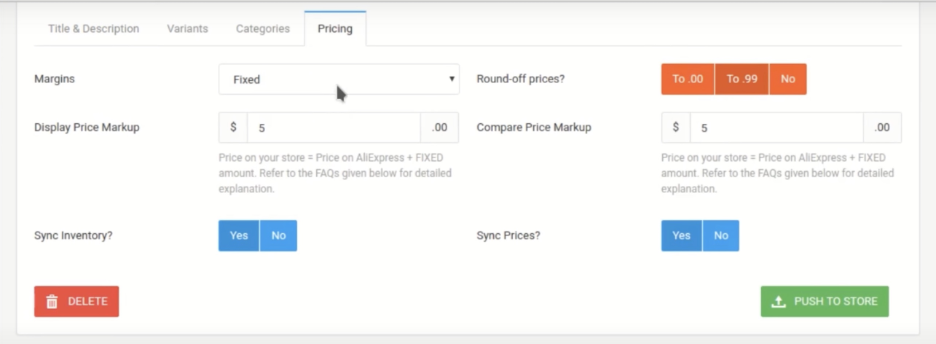
- Now that you’ve completed all of the modifications, you can use Woodropship to push the items into your store. It’s just a click away.


Selling process.
- Once you receive an order, you’ll be alerted on the dashboard.
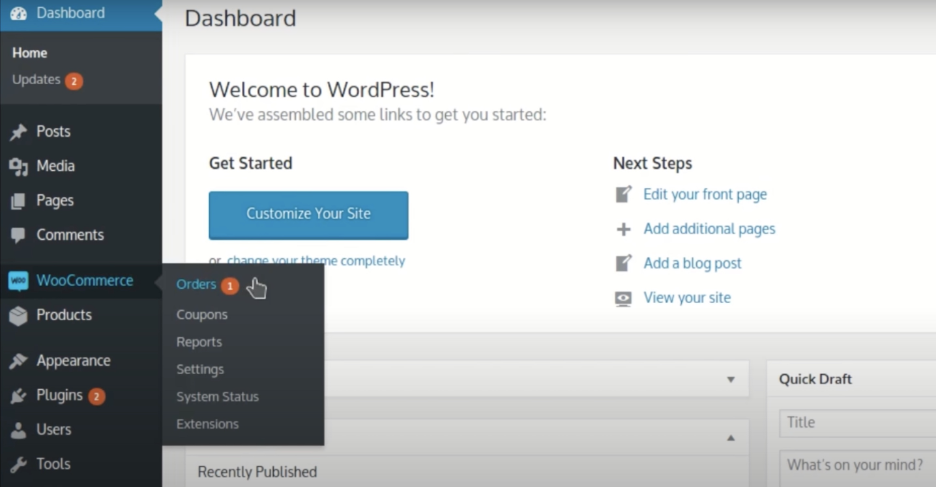
The developer has made the order fulfillment process fully automatic. Just one click and WooDropShip Chrome extension will add the product variants to the cart and fill out the customer details for you

- Now you’ll push the order over to the Aliexpress vendor. WooDropship can fill in the customer’s information for you automatically.
After you receive an order for products imported using WooDropShip, you need to order those products on Aliexpress comm with WooDropShip Chrome extension.
All you need to do is pay for the products, and you’re done. After you’ve successfully placed the order, you can add the order ID to WooDropShip, and the app will automatically update the order status on your store and notify your customer about the order status as it changes
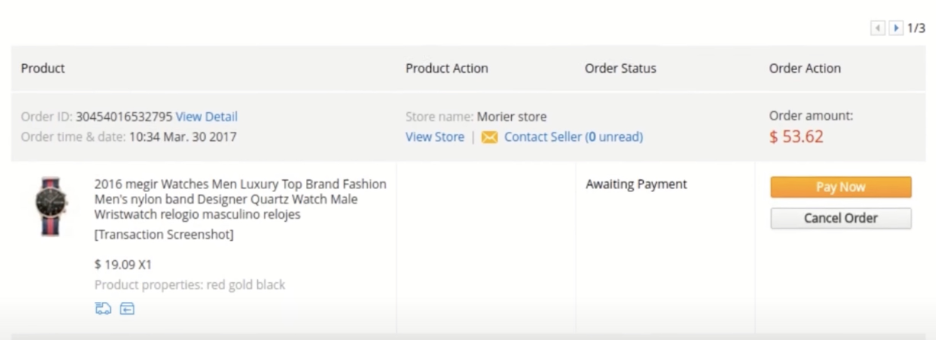
-
The drop-shipping distributors will then deliver the goods on your behalf to the buyer.
-
If your customer has a query, you should be able to respond quickly.
You can see your total sales, as well as the number of orders and supplies in your store, on your WooDropship dashboard. Furthermore, Woodropship can dynamically handle product availability and pricing updates for you.
You can get started with a free 14-day trial, no credit card required, no strings attached.
Conclusion
Are you ready to start dropshipping with Aliexpress and/or BigCommerce? Simply follow the steps outlined above to make your AliExpress dropshipping journey a triumph.
We want you to be successful and rise ahead of the curve. However, Drop-shipping is not always an easy-money scheme. We don’t want to give the impression that we’re against dropshipping; on the contrary, we believe it’s a very effective strategy when used correctly.
I wish you a prosperous Dropshipping.





